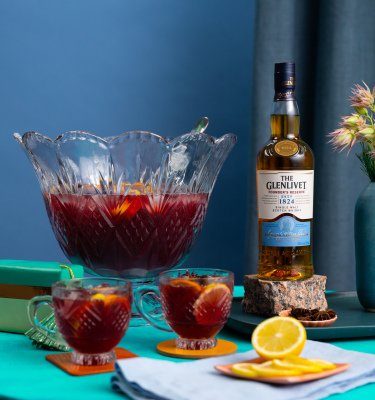
Discover how scotch is made in Speyside
From The Glenlivet guide to whisky
When The Glenlivet founder George Smith first started making whisky, he did so illicitly, with his distillery tucked away in the Livet valley. It soon became world-renowned with everyone from authors to kings seeking a dram. Today, we’re prouder than ever of the nearly 200 years of history that have made The Glenlivet scotch whisky what it is.
To make sure that our heritage is infused into each and every sip, we use a time-honoured process to make our single malt scotch. And we carefully check every step to keep our scotch whisky smooth and balanced.
If you’ve ever wondered how scotch is made, you should join us in our Process Room in Speyside to find out. Don’t worry, you don’t have to put your shoes on or even leave the comfort of your chair. We’ll explain every stage in detail from barley to bottle throughout our virtual tour.
Once you’ve discovered how we transform grain into The Glenlivet, why not head to the Tasting Room where we share whisky cocktail recipes for some of our signature serves? Or take the Flavour Explorer quiz to find out which bottle of The Glenlivet is the perfect match for your palate.
Malting
The first step in making our smooth scotch whisky is malting. Barley is soaked in water, a process also known as steeping, to wake up the dormant grain. Over a couple of days, the barley is submerged, drained, and allowed to rest in the air. The perfect combination of air and water exposure must be achieved to raise the moisture content of the seed to the point where germination begins.
After soaking, the barley is spread out to dry and allow germination to continue. It’s at this point that starch from the barley begins converting into sugar. The approach to germination is part art, part science. The time it takes for the barley to sprout can vary and must be monitored with careful control of temperature, moisture levels and airflow.
Then comes drying. The barley, which after germination is known as green malt, is transferred to a kiln. This stops germination which would otherwise use all the seeds’ starch reserves for growing.
Milling
Once the malted barley has been dried, it becomes crispy and requires milling. This is a critical process in scotch production as it impacts how much sugar can be extracted during the next stage. The barley is ground down into a powder called grist. The consistency of the grist is what is key. If it’s too fine, the soluble sugars will not be picked up and the mash and equipment can become sticky. But too coarse and water will just run through.
Mashing
Next comes mashing but there are no potatoes involved. Mineral-rich water is combined with the grist in a vessel called a mash tun. The water is added in stages. The first filling is hot and subsequent fills are hotter until they are almost boiling, as this allows the sugar from the barley to be dissolved into the liquid.
The mash must be stirred for some time as this helps convert the starch to sugar. This used to be done by hand with shovels but as technology developed, the stirring was mechanised. This makes the mashing process easier but also faster and more efficient.
Fermentation
After mashing, the resulting sweet, sugary liquid, known as wort, is pumped out into washbacks and cooled. Yeast is added at this stage to kickstart the process of fermentation. The living yeast feeds on the sugar, which produces alcohol, more specifically ethanol, and small quantities of other compounds known as congeners. Congeners actually contribute to the taste and aroma of our scotch, so whilst small, they are mighty.
Distillation
The wash, which is the liquid that’s left after fermentation has finished, now needs to be distilled. Here at The Glenlivet, our wash liquid is twice distilled for purity. Pot stills are used for this stage and their shape plays an integral part in the character of the whisky. That’s why we still use George Smith’s pioneering lantern-shaped stills.
During distillation, the still is heated to just below the boiling point of water. This causes the alcohol and other compounds to vaporise. The vapours pass over the neck of the still into another container called a condenser. This container is immersed in cold running water. As the vapour enters the condenser, it is cooled, turning it back into a liquid.
The result after the first distillation is called low wines. It must be distilled again to remove some remaining compounds that we just don’t want in our final product. The second distillation creates a more concentrated liquid as additional water has been removed. This clear liquid is now ready to rest up in oak casks.
Maturation
For scotch to be classified as such, it must be aged for a minimum of three years in oak casks. Every stage of how scotch is made is important but this final step before bottling is truly special. The wood from the casks passes its character over to the whisky. It’s the history of nature and the history of human innovation coming together.
The notes shared include wood, vanilla and toffee but are unique to the barrels. For example, The Glenlivet Caribbean Reserve Single Malt gains its tropical flavour from barrels that previously held Caribbean rum. And with The Glenlivet White Oak Reserve, ex-sherry, American oak and traditional oak casks are brought together to impart sweet, velvety notes on the scotch.
Once our scotch whisky has been aged to perfection, we bottle it. It’s then ready to be enjoyed by whisky lovers all over the world. And we have plenty of unique casks and finishes that have been crafted by staying true to our roots, whilst injecting new and contemporary ideas.
Whether you want to create exciting whisky cocktails that you can serve at an outdoor dinner party, or you’re a purist who likes to keep things classic with 18 year old scotch on the rocks, our single malt scotch is for all.
Now that you know how scotch is made, why not find out more about the country that The Glenlivet calls home by checking out our guide to things to do in Speyside or brushing up on Burns Night traditions?


